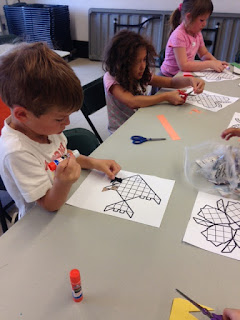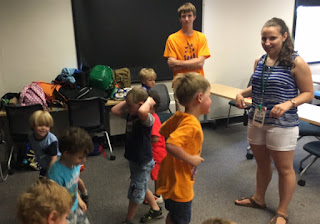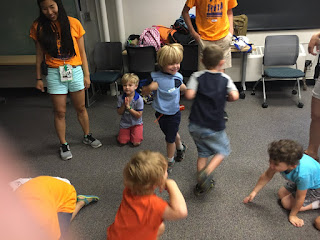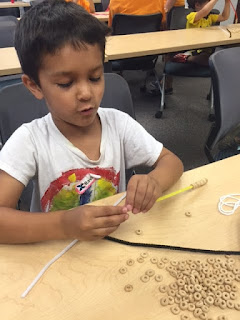We have had a fun week looking into the past! Take a look at some of the archaeological adventures we had at Camp Explorations this week:
On Monday, we stepped back in time to 3600 BC to visit Ancient Mesopotamia. We built 3D maps of Mesopotamia to illustrate places like the Arabian Desert, the Zagros Mountains, and important Mesopotamian cities like Uruk, Ur, Babylon, and Nineveh. We compared the map of Ancient Mesopotamia to what the region looks like today. the Arabian Desert, Zagros Mountains, and the many seas and rivers surrounding the area remain the same, but the region is now divided into the countries of the Middle East. We then learned about two forms of communication invented by the Sumerians in Mesopotamia. We made cylinder seals, or cylinders engraved with a 'picture story' and used to roll impressions onto clay, and practiced rolling them out onto clay. Although Mesopotamian cylinder seals were made using stone, glass or clay, we made ours using cylindrical containers like Pringles tubes, and attached foam stickers to create our picture stories. We also practiced writing in cuneiform, a Sumerian system of writing. We included an image of the cuneiform alphabet in our weekly questions post, if you would like to take a look! We finished our adventure in Mesopotamia with a Sumerian Game, in which we walked through a day in the life of a Sumerian person in Mesopotamia and had to make decisions similar to the ones Sumerians had to make- such as whether to carry buckets of water from a far away river to water crops or build irrigation streams, or whether to protect the city-state by building walls and moats or having people stand guard around the city 24 hours/day.
 |
| Campers make a 3D Mesopotamia map |
 |
| Campers make their cylinder seals |
 |
Campers get some background information
before playing the Sumerian game |
On Tuesday, the Purple group and half of the Orange group went to the Kelsey Museum of Archaeology for a program about myths and monsters, and the rest of the campers stayed at the Museum of Natural History to learn about Ancient China. At the Kelsey Museum, campers looked at archaeological pottery pieces, toured the galleries to learn about ancient myths and monsters, and even got to create their own monsters! At the Museum of Natural History, we had a variety of games and activities to help us venture back to China circa 1900 BC. For our craft of the day, campers made terracotta soldiers like the ones that comprise the Terracotta Army, a recreation of Emperor Qin's army hat have been used to protect his tomb. We played a Marco Polo Silk Road game, where campers traveled along the journey that Marco Polo made between Italy and China, trading goods as they went and learning about historical trade routes and some of the difficulties and dangers travelers would have faced. Campers also got to experience two games the kids in Ancient China would play. Tangrams are an Ancient Chinese puzzle using 7 geometric shapes to create different images. Campers had fun arranging the pieces to create different kinds of animals. We also played the Game of Nim, in which stones are set out in rows and players pick up stones according to certain rules, hoping to leave their opponent with the last stone.
 |
| A camper shows off his terracotta creation |
 |
| Campers make images with tangrams |
 |
| Campers make mythical monsters at the Kelsey Museum |
 |
Campers determine strategies while
playing Marco Polo Silk Road |
On Thursday, Yellow group and the other half of Orange group went to the Kelsey for their turn at myths and monsters, while the rest of the campers stayed at the Museum of Natural History for their trip to Ancient China. While the campers here enjoyed some of the same activities from Tuesday, like Tangrams and the Game of Nim, they also explored Chinese ming bowls and pictograms. Ming bowls are clay bowls decorated with blue paint. Campers got to look at some traditional Chinese designs, and then make their own bowls using clay and blue paint. Campers also got to paint some stories with Chinese pictograms and learned about how the pictograms use images to tell stories.
 |
| Campers make images with tangrams |
 |
| Campers make images with tangrams |
 |
| A camper paints his ming bowl |

 |
| Campers paints their ming bowls |
 |
| Campers play the Game of Nim |
 |
| Campers make mythical monsters at the Kelsey Museum |
On Friday, we delved a little deeper into the archaeological process and learned about how archaeologists work. We read a diary entry from a 9-year old boy living in 1845, and thought about what items archaeologists might find when excavating the boy's backyard. We learned about the difference between an artifact, objects that were used or made by people, and ecofacts, environmental remains. We looked at some objects found at a dig site and determined whether they are artifacts or ecofacts, and what their purpose may have been. Then we did a stratigraphy activity where we matched artifacts to their appropriate time period, Modern, colonial, or Prehistoric, and then taped them to a diagram of stratified soil layers. The bottom layer was the oldest, Prehistoric times, and included items such as mastodon artifacts and an arrowhead. The middle layer, Colonial times, had artifacts like shoe remnants and an old knife. The top layer, Modern times, showed us a computer, a motorcycle, and other modern-day conveniences. The times sure have changed! Campers also went to a planetarium show called Stories My Ancestors Told, where they learned about Native American creation stories and how archaeologists can use their discoveries to share stories of the past. Finally, we did a pottery dig and used our archaeology skills to interpret some of the images on the pottery.
 |
| Campers put artifacts in the correct layer of soil |
 |
Campers look at artifacts from an
archaeological site and determine
what they were used for |
 |
| Campers dig for pottery |
We cannot believe we are already entering August and our 7th week of camp! This summer is flying by, but we hope to see some of you again this summer. Next week is CSI: Ann Arbor in the morning and Paleontology Rocks in the afternoon!























































































